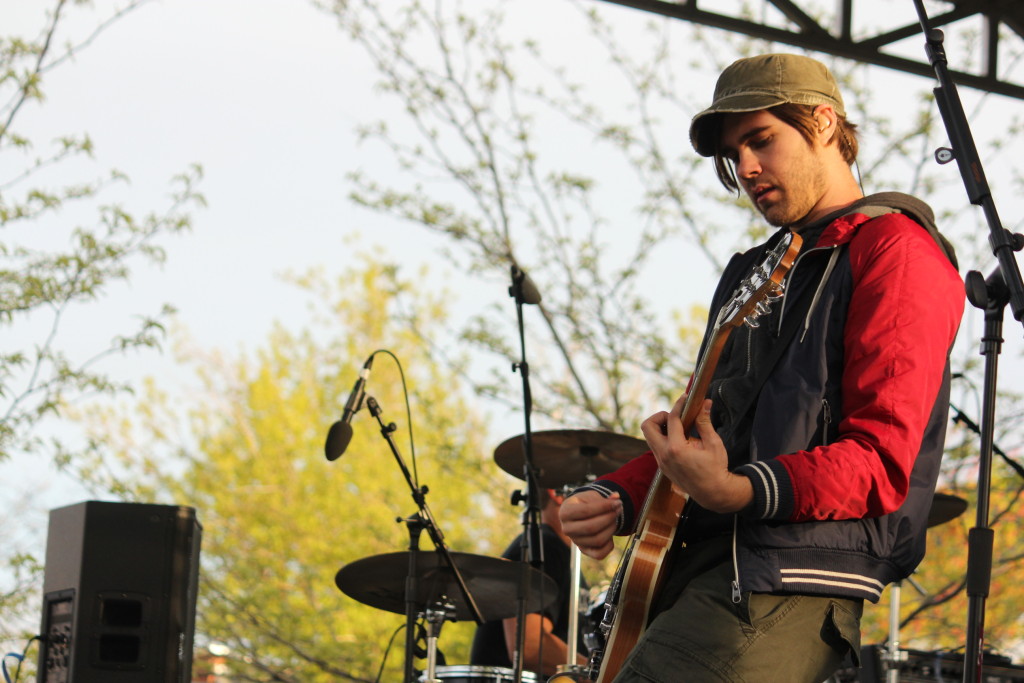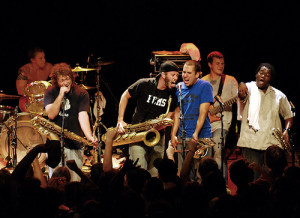This is part 1 of my Tomas Kalnoky/Streetlight Manifesto retrospective
Streetlight Manifesto — in conjunction with Tomas Kalnoky’s various acts — is my favorte musical artist of the past quarter century.
It was a steady uphill climb. Driven by Kalnoky’s unique and sublime songwriting, I’ve been a fan since he was a teenager writing for ska-punk outfit Catch 22.
After Catch 22 — and after a very brief time with the now-legendary “collective” Bandits of the Acoustic Revolution — Kalnoky went on to form Streetlight Manifesto. Ostensibly a ska band, but really so much more, Streetlight Manifesto is my favorite band of all time.
Streetlight has released three albums of original songs, plus two cover albums (one of which is a song-for-song recreation of the old Catch 22 album, Keasbey Nights. It’s confusing.)
From the start, Streetlight’s greatness was exceedingly obvious. And, miraculously, they got better and better during the ten-ish years before going on an indefinite hiatus in 2013.
But let’s take a step back. Let me try to describe Streetlight’s sound, from the core outwards.
The center of Streetlight Manifesto’s music — the thing that drives all of the other pieces in the music — is Kalnoky’s songwriting.

Kalnoky has said the soundtrack to Stand By Me, a compilation of 1950s rock and roll classics, is the album that had the biggest impact on his songwriting.
I have a theory that Kalnoky fell into ska by accident, because there’s nothing particularly ska-ish about his compositions. Kalnoky’s melodies seem inspired in large part by ‘50s rock: driving, upbeat, and full of hooks.
The mentality and aggression in Kalnoky’s lyrics and vocals imply a punk attitude, with an earnest, narrative-driven edge. This is especially true on Keasbey Nights, the closest thing to a true punk album that Kalnoky every wrote.
The last major defining element of Kalnoky’s writing, especially in his Streetlight days, is the complexity of his arrangements. These songs incorporate a number of styles and influences, often in the span of a few seconds. Kalnoky emphasizes virtuosic solos and instrumental accompaniment. The length and density of the tracks gives Streetlight Manifesto an almost progressive sound.
But what makes the band truly essential is that these disparate parts and complex songs never distract from the music: They only amplify the energy and the melodies. If I had to choose one thing that makes Streetlight Manifesto great, it’s that the brilliance of each performance, of each part of the arrangement, are all connected into tight, muscular tracks that each sound like mini-masterpieces.
Kalnoky has been blessed with great musicians throughout his career. This was first noticeable on Keasbey Nights, on which each instrumental player holds their own. When he formed BotAR, he assembled an incredible lineup of talent.
But when it comes to instrumental talent, Streetlight Manifesto shines more than any band I’ve ever heard. Their lineup reads like a supergroup: you can make a case for just about any member to not only be the most talented in the band, but to be the best you’ve ever heard at that instrument.
Great instrumental talent is a crucial part of any great band, but it’s particularly important for Streetlight Manifesto for two reasons:
First, a lot of the charm of Streetlight’s songs comes from the rich, satisfying soundscape that’s a result of the band’s instrumentation. Simply, the acoustic timbre of wind instruments just SOUNDS better than most electric or synthesized rock. The beautiful tone and overall stunning musicianship of each performer in Streetlight maximizes the full, energetic sound of the band’s recordings.
The second reason that Streetlight Manifesto’s great instrumental talent is a major ingredient in their success is because it means their live shows are lights-out, world-class concerts.
 Kalnoky and his bands’ dedication to making every moment of every track magnificent meant that every album was an event… and that there were frustratingly long waits between albums.
Kalnoky and his bands’ dedication to making every moment of every track magnificent meant that every album was an event… and that there were frustratingly long waits between albums.
Kalnoky formed his first band, a punk group named Gimp, in 1996 with some of his high school friends at age fifteen. They recorded one album, Smiles for Macavity, that never had a wide release, but is easily found with some Googling. It’s not a particularly good album, though a few moments show some creativity.
(The most enduring legacy of Gimp is one of its songs, “Mrs. Butterworth’s Indestructible Bomb Shelter,” becoming an inside joke among Kalnoky’s fans. At every show, you’ll hear people shouting a request for him to play “Mrs. Butterworth!” This joke peaked when Streetlight opened a facebook thread to collect requests for the band’s final, pre-hiatus shows. At the actual show, Kalnoky opened by saying he wasn’t going to play Mrs. Butterworth, and threatening to have security kick out a fan who was shouting for him to play it. Kalnoky’s a fun guy.)
Later in high school, he formed Catch 22, the band that would be his breakout. The third-wave ska fad was on its way out, but must have left a strong impression on Kalnoky. Catch 22 featured a trumpet, sax, and trombone player (the latter also contributing some flute, french horn, and penny whistle).
In 1998 — after a self-printed EP cassette caught the attention of Victory Records — Catch 22 released their first album, titled Keasbey Nights. It had pretty strong sales and received positive reviews, but it would go on to become an adored touchstone in punk and ska.
 Count me among those who consider Keasbey Nights a masterpiece. Kalnoky blends teenage angst with vivid imagery of violence and isolation. The biting punk blends smoothly with the pleasant instrumental parts.
Count me among those who consider Keasbey Nights a masterpiece. Kalnoky blends teenage angst with vivid imagery of violence and isolation. The biting punk blends smoothly with the pleasant instrumental parts.
But it’s the consistently great songs and their cohesion that make this such a satisfying listen. Kalnoky has a great ear for catchy hooks, borrowing melodies from classical and classic rock, but giving them a stinging, angry edge.
 The performances are great all around, with two particular standouts. First, the busy drumming by Chris Greer propels the best tracks, most notably the blistering closer “1234 1234”.
The performances are great all around, with two particular standouts. First, the busy drumming by Chris Greer propels the best tracks, most notably the blistering closer “1234 1234”.
The second standout is Kalnoky on vocals: His vocal range and control are not particularly great, but there’s a moving expressiveness and vulnerability lurking beneath his on-edge vocal part.
The title track is immensely catchy and was a minor hit. It’s among the best here, but there are a half dozen tracks that are just as good: “Day In Day Out,” “On & On & On,” “Dear Sergio,” “Kristina She Don’t Know I Exist,” and “1234 1234” are all gems.
It all adds up to an exciting and moving portrait of teenage angst fueled by a mother’s sickness (“As the Footsteps Die Out Forever”), identity crises (“Day In, Day Out”), girl troubles (“Kristina”), and general self-doubt (“Supernothing”) — punctuated by fantasies of violence (“Keasbey Nights,” “9mm and a Three-Piece Suit”).
Not long after the release of Keasbey Nights, Kalnoky developed some sort of beef with the rest of the members of Catch 22 and quit the band.
 In 2001, Kalnoky reappeared writing songs for a new band… or, as he called it, a “collective.” The band was named Bandits of the Acoustic Revoluatoin (aka BotAR), and their debut EP contained five songs, one of which was an intro track and one of which was a cover of “Dear Sergio” from Keasbey Nights. (In other words – only three songs of new material.)
In 2001, Kalnoky reappeared writing songs for a new band… or, as he called it, a “collective.” The band was named Bandits of the Acoustic Revoluatoin (aka BotAR), and their debut EP contained five songs, one of which was an intro track and one of which was a cover of “Dear Sergio” from Keasbey Nights. (In other words – only three songs of new material.)
Despite the lean duration of the album, it leaves an extremely strong impression and is even more of a “cult hit” than Keasbey Nights, adored by its smallish group of obsessive fans… which would definitely include me.
BotAR’s album elevates Kalnoky’s arrangements with a sweeping, symphonic sound that includes violin, french horn, upright bass, and more. It’s an utterly unique timbre, monumental and expressive.
Adding to the intriguing sound of BotAR is the dichotomy of its songwriting: The tunes have a loose, upbeat sound; paired with Kalnoky’s often dark lyrics about war, suicide, and suffering, they give the album a strange, oddly satisfying flavor.
BotAR’s impact has dwindled over time. Of the three unique BotAR tracks, two have been covered by Streetlight Manifesto, leaving only one song — “It’s a Wonderful Life” — as one unique to BotAR. I hope with all my might that no other Kalnoky band records the song because it’s perhaps his best song ever, absolutely perfect in its lone public recording.
Alas, the Bandits were not meant to be; despite occasional promises from Kalnoky that the band would someday reunite, the EP is the only thing we’ve ever heard from BotAR… and it may very well be that way for all time.
What a ride it is, though: That five-track EP is my all-time “what if” album; it shows the brewing of something special and makes you wonder what heights they could have reached if only the logistics of the band staying together had worked. A second BotAR album is near the top of my mythical wish list.








Tomas is a huge influence to my work as an author, to the point where I am constantly referencing his work. It’s to the point where all my friends call me Botar.